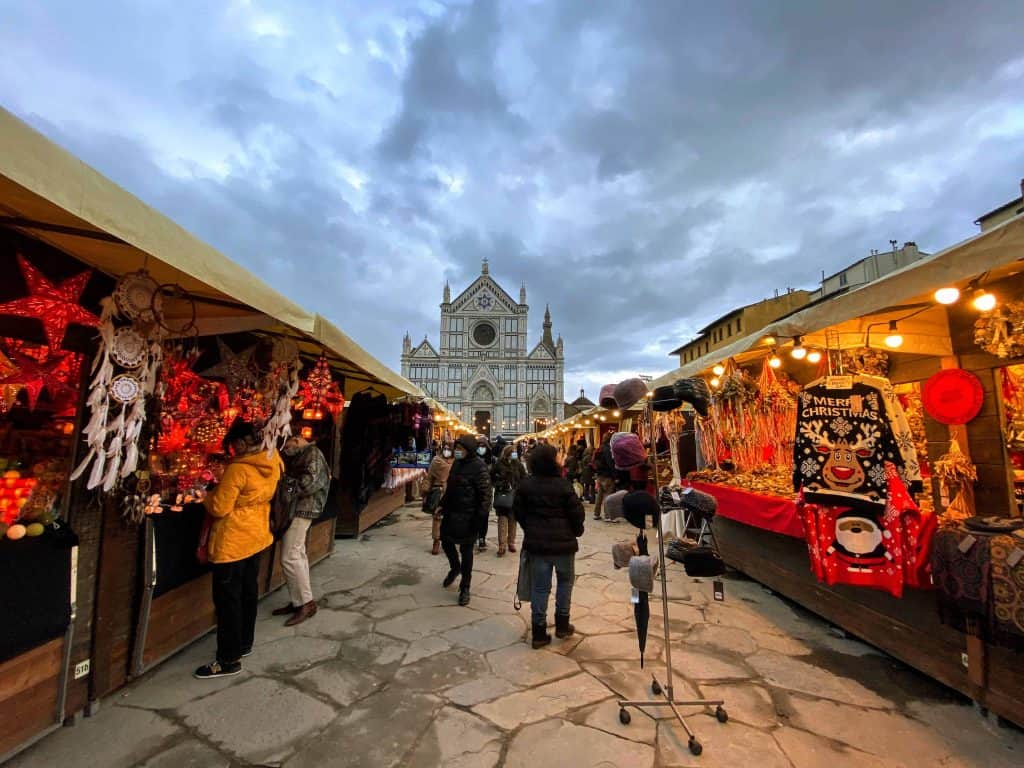Updated on November 7, 2023
Italy’s Festa della Donna – International Women’s Day
“Ogni volta che una donna lotta per se stessa, lotta per tutte le donne.” (“Each time a woman stands up for herself, without knowing it possibly, without claiming it, she stands up for all women.”) -Maya Angelou
If you’re anywhere in Italy on March 8th, you’ll see yellow flowers everywhere – in grocery stores, flower shops, on office desks, on kitchen tables, and in the hands of women old and young.
Why?
On March 8th, Italy celebrates La Festa della Donna, International Women’s Day, with women around the world. The yellow mimosa flower is the flower given to women on their special day. I’ll explain why we give the mimosa flower below. But, first a little bit of background on La Festa della Donna:
What is La Festa della Donna?
La Festa della Donna, (sometimes called La Festa delle Donne) is a celebration of women. It honors their past struggles (& victories) working toward economic, political, and social equality.
It also serves as a reminder of how much more progress needs to be made to secure equality for women in Italy and to eliminate gender discrimination and violence toward Italian women.
La Festa della Donna is Italy’s celebration of International Women’s Day, recognized by the United Nations and many countries around the world.
While it marks a serious occasion, it’s also a cheerful, loving celebration of women. Women are celebrated by their families, friends, co-workers, neighbors, and acquaintances.
When is La Festa della Donna Celebrated in Italy?

It’s celebrated on March 8th.
The History Behind International Women’s Day & La Festa della Donna
The first National Woman’s Day was held in NYC, US on February 28, 1909 and included events on voting rights and socialist causes.
Then, a couple of years later (March 19, 1911), the first International Woman’s Day took place in Europe (Austria, Denmark, Germany, Switzerland), with huge turnouts, continuing to push for women’s rights.
On March 8, 1917*, a huge Russian protest led to women in Russia being granted the right to vote and Woman’s Day became a holiday in Russia and other communist countries.
*Interesting Fact: It was actually the last Sunday in February (the 23rd), but Russia hadn’t yet adopted the Gregorian calendar. February 23rd’s corresponding date in the Gregorian calendar is March 8th – the day we mark as International Women’s Day.
Over time, the holiday became known as International Women’s Day (vs. Woman’s Day) and more and more countries celebrated it.
Italy first celebrated the holiday in 1922.
1975 marked the UN’s official recognition of March 8th as International Women’s Day, and it’s celebrated throughout the world.
Why Do We Give the Yellow Mimosa Flower for La Festa della Donna in Italy?

The Tradition of Giving Mimosa Flowers in Italy
The tradition of giving out yellow mimosa flowers dates to 1946. The Italian partisan and political activist Teresa Mattei (nickname Teresita) decided that France’s traditionally-gifted violets and lilies of the valley were too expensive for the people of rural, impoverished Italy.
Mattei, along with fellow women’s rights campaigner Rita Montagnana, decided to begin giving out the yellow mimosa (aka acacia) flower to other women as a symbol of:
- Support
- Respect
- Sisterhood
Good To Know: The mimosa flower – you may know it better as the acacia flower. It has a lovely scent, with notes of honey and iris and it has long been used in incense and perfumes.
Symbolic Meaning of the Mimosa Flowers in Italy
Activists Mattei and Montagnana chose the mimosa for symbolic and practical reasons:
- The mimosa consistently flowers in late-February to early March.
- It’s found throughout Italy.
- It isn’t cost-prohibitive.
- Its puffy yellow flowers make the plant look fragile, but mimosas are indeed strong and can survive in difficult conditions – just like women.
- The mimosa tree has edible fruits and seeds, its bark produces a gum that is used in printing and as a food stabilizer, and its wood is used to make gorgeous furniture. It can do so much – just like women.
Small bunches or bouquets of mimosa can be purchased at supermarkets, florists, small shops, and gifted from morning to evening.
Good To Know: You can also pick wild mimosa if it belongs to you. Please don’t take mimosa from gardens or public parks. And don’t purchase mimosa from street vendors – the flowers are often harvested illegally from public plants.
How to Celebrate and Honor Women for La Festa della Donna in Italy
- Bouquet of yellow mimosa flowers are gifted. This is the most common gesture of La Festa della Donna.
- Special meals at home or at a restaurant. Some restaurants have dedicated menus. Women go out with other women friends, their families, or just their significant others. Some bars offer a special aperitivo for women – cheers!
- Cards or small gifts.
- Baked or gifted mimosa cakes. There are many different versions of this cake. The ones that make the best impression are decorated to look like they’re covered in delicate yellow mimosa flowers.
- WhatsApp messages. Like most Italian holidays, La Festa della Donna sees a flurry of WhatsApp messages arriving via WhatsApp, often with a phrase about women and a photo of mimosa flowers.
- Phone calls. Even better than a message on the phone!
- Talking about and remembering Italian women who advanced women’s rights and welfare in Italy.
- Women’s marches or demonstrations take place in cities throughout Italy.
- Free entrance to some museums. There may also be special events and speakers.
- Free doctor’s visits. Some clinics and doctors’ offices provide free gynecological check-ups and other exams related to women’s health.
- General strikes. These are hotly contested, as they usually make life more difficult for women.
- Television specials and investigations on women’s rights, domestic violence, gender equality and the wage gap.
- Special events in cities. For example, Venice has a Sunday afternoon women’s boat race and a parade of gondolas decorated with mimosa flowers.

How Do You Wish Someone in Italy a Good Festa della Donna?
Do you want to know how to wish someone a happy International Women’s Day / Festa della Donna in Italy?
You say: Buona Festa della Donna!
If someone wishes you a Buona Festa della Donna, you can say in return: Grazie! (Thanks!)
And, if it’s a woman wishing you a Buona Festa della Donna, you can say: Grazie, anche a te! (Thanks, you too!)
Do All Italian Women Celebrate La Festa della Donna?
Some women in Italy aren’t overjoyed with the holiday in current times, as they see it’s left its political/activist roots behind and is becoming more of a commercial holiday like Valentine’s Day. They want the holiday to stay focused on women’s rights and progress, not giving flowers and gifts.
A ‘Buona Festa della Donna’ shouldn’t be offensive to any woman, but not all will be delighted with a box of chocolates.
And, even women who are happy to receive gifts and extra love on the holiday still want to advance women’s rights. The two groups aren’t mutually exclusive.
So, besides giving out bouquets of Mimosa flowers, think about what small gesture you could make to promote the advancement of women’s rights in Italy and abroad.
Some of Italy’s Exceptional Women

- Margherita Ancona – worked tirelessly to help gain the right to vote for Italian women
- Asia Argento – actress and women’s rights activist who called for accountability in the film industry
- Eugenia Bonetti – a nun who works tirelessly to help free women from prostitution in Italy and rescue women from human traffickers
- Emma Bonino – fought to secure abortion rights for Italian women
- Alice Schiavoni Bosio – campaigned for women’s rights, women’s voting rights, and refugees’ rights.
- Antonella Bundu – activist and first black woman to run for mayor of a major Italian city (Florence, 2019)
- Francesca Cavallo – co-author of the international best-selling Rebel Girls series and activist for gender equality and LGBTQ rights.
- Grazie Deledda – first Italian woman to win the Nobel prize for literature (1926)
- Elena Favilli – co-author of the international best-selling Rebel Girls series
- Chiara Ferragni – self-made businesswoman and influencer who encourages women to pursue their business and personal dreams
- Artemisia Gentileschi – first female member of Florence’s L’Accademia delle Arti del Disegno; 17th century artist known for painting strong and brave females
- Margherita Hack – astrophysicist and first woman in Italy to head an observatory (at the University of Trieste)
- Teresa Labriola – in 1912, became Italy’s first female lawyer
- Anna Magnani – won Italy’s first Academy Award (best actress, 1955); she once told a makeup artist who tried to cover the lines on her face, “Please don’t retouch my wrinkles. It took me so long to earn them!”
- Teresa Mattei – ‘Chicchi’ was her war nickname, this partisan introduced the mimosa flower as the symbol of the festa della donna in Italy
- Rita Montagnana – politician and activist
- Rita Levi Montalcini – winner of Nobel Prize for Medicine (1986), she continued with her experiments even while in hiding during WWII
- Maria Montessori – creator of the child-centric Montessori schooling approach
- Elena Lucrezia Cornaro Piscopia – the first woman to graduate from university (June 25th, 1678); graduated from Università deli Studi di Padova
Word Search of Exceptional Italian Women
I hope now you’ll appreciate the meaning of giving a yellow mimosa bouquet to a woman on La Festa della Donna in Italy!
If you’d like to learn more about International Women’s Day, UN Women is a great resource:
La Festa della Donna FAQ
The holiday is being celebrated more in the United States, especially in March of 2018, following the MeToo movement’s rapid growth in late-2017.
The holiday wasn’t popular before then, probably due to its communist and socialist roots.
American marketers have caught on that, along with other holidays like Valentine’s Day, it can bring in huge profits.
Hopefully the main idea of March 8th won’t get lost.
No. Actually, Italy has one of the lowest wage gaps in Europe – at 4.7%.  Source: Eurostat Gender Pay Gap statistics
Source: Eurostat Gender Pay Gap statistics
However, the gender wage gap in Italy is likely lower because the country has a high unemployment rate for women and the women that do enter the labor force enter in high-paying jobs.
No. You can decide who to gift a bouquet to. In our family, men gift them to close friends and family and women gift them to friends and co-workers. We also give them to daughters of close friends.




